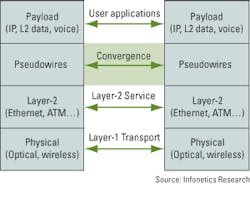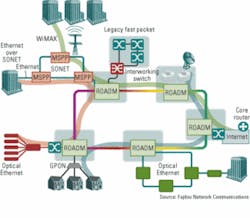Pseudowire technology has garnered a great deal of interest at recent conferences and trade shows, especially from the carriers, who are uncharacteristically forthcoming about their interest. The carriers say the benefits of this new transport mechanism are numerous, though widespread deployment will likely hinge on the ratification of the pseudowire standard, the availability of equipment at the right price points, and the development of a market for the services pseudowires enable.
A pseudowire is a universal transport mechanism for the converged Internet Protocol/Multiprotocol Label Switched (IP/MPLS) network (see Figure 1). It creates a point-to point logical or virtual connection that carries packets, cells, or bit streams in packet-based networks. Pseudowires also enable the transport of legacy TDM, Frame Relay, and ATM services over an IP/Ethernet network. With so many carriers providing Ethernet-based services, both in the core and the access, this capability is critical.
“Ethernet access is happening, and it will continue to happen for all the right reasons,” contends Don Sparks, CTO of General Bandwidth (Austin, TX). “Now I can offer new services on top of Ethernet that I can’t do today over TDM, like VoIP [voice-over-IP]. But I also have the ability to pick up legacy equipment and provide a type of virtual circuit to my core. That is what pseudowire is.”
“A pseudowire is more than just the frame format,” adds Sam Lisle, director of market development at Fujitsu Network Communications (Richardson, TX). “It’s also the rules for encapsulating these multiple protocols onto that frame.” When you map Ethernet into a pseudowire, for example, it bears all the characteristics of the Ethernet connection it is carrying. If a certain priority bit is marked into the Ethernet frame, you can mimic or replicate that capability in the pseudowire, he explains.
“So now that I’ve got this connection-oriented layer, this pseudowire layer that has value because now I can carry multiple protocols across my IP/MPLS core, can I leverage this technology in other settings?” ponders Lisle. “That’s where I think there’s additional interest [from the carriers]. They are using it in a transport context, not necessarily in a routing context.”
One such carrier is MCI (Ashburn, VA), which has made pseudowire technology the cornerstone of its converged packet access (CPA) architecture. “CPA allows us to deliver Ethernet services, which, over time, will be the most common access method into the network,” explains Jack Wimmer, MCI’s vice president of network architecture and advanced technology. “But it’s really a more general-purpose architecture. It’s a better way of building connectivity than T1s.”
MCI is delivering its initial suite of Ethernet services across the CPA architecture using virtual LANs (VLANs) but expects to implement the next phase of its access strategy in 2006. “The plan is and has always been to very quickly migrate from a VLAN infrastructure to a pseudowire infrastructure,” contends Wimmer. “Still presenting to the customer a standard Ethernet interface with VLANs, but from that demarc[ation] back into our network, we will migrate to pseudowires as the transport mechanism.”For now, pseudowire technology is fully functioning in MCI’s labs using equipment from multiple vendors, reports Wimmer. “We have some steps to go through to get the software releases of those vendors to GA [general availability] position, which we think will happen around the middle of [this] year,” he adds. “We will then begin rolling it out into the network.”
Wimmer is quick to note that MCI does not have to replace any hardware to accomplish this upgrade; it will be accomplished entirely through software. “This has always been part of the strategy,” he says. “We’ve already deployed general-purpose Layer 2 packet switches, and the difference to the switch is simply the bits and bytes that it acts upon.”
Incumbent carriers like MCI, typically reticent to tip their individual and collective hands about any strategic decision, have been especially vocal about their interest in pseudowire technology. According to Michael Howard, principal analyst and co-founder of Infonetics Research (Campbell, CA), service providers are excited about the prospect that pseudowires could become the new “leased lines” of the converged packet network. “They can be used to provision in a single technique-encapsulation method with QoS [quality of service]-any and all Frame Relay, ATM, leased lines, Ethernet, and voice traffic; it’s a universal logical transport.”
At SuperComm last year, Howard sat in on two separate panels featuring representatives from MCI, BellSouth, AT&T, and Verizon. “Here they were talking about pseudowires out in public,” he muses. “They were talking about their hopes and plans for pseudowires, and yet it’s still kind of a subtechnology. It is a subtext story in IP/MPLS convergence.”
If the carriers continue to tout pseudowire technology so publicly, it may not remain a subtext story much longer-and for good reason. For MCI, pseudowires represent the promise of automated provisioning, which is critical in the high-volume enterprise market. Provisioning a logical circuit in today’s Ethernet environment requires several steps; each switch has its own provisioning process that is loosely analogous to the provisioning of a T1 through a set of digital crossconnects in a TDM environment, says Wimmer.
“With the signaling capability of the pseudowires, our provisioning systems will simply go address the two end points-the origin and destination of the connection we want to make-and direct those end points to signal each other,” Wimmer explains. “The signaling will find the appropriate path across the network, establish the connection, verify it, and then report back that it’s been done.”
The automated provisioning enabled by pseudowire technology is roughly analogous to the signaling of phone calls across the PSTN, adds Wimmer. A number is dialed, it goes through an SS7 network, the path is calculated, the call is tested, and the connection is established quickly. The protocols and mechanism may be different, he says, but functionally, the process is very similar.
Pseudowires offer numerous additional benefits. For example, they are far more robust than basic Ethernet and address some of the fundamental scaling limits of Ethernet, which really was designed for a campus-type environment, notes Mick Duckett, BellSouth’s research director for IPTV and former senior director of the carrier’s packet switched infrastructure. “Traditional Ethernet bridging doesn’t address a global connectivity arrangement where you would take Ethernet and deliver it somewhere on a wide-area basis,” he explains. “In my opinion, it has morphed into something that isn’t scalable.”Pseudowires, by contrast, are scalable across the WAN and form a bridge between disparate transport technologies, including SONET, resilient packet ring (RPR), WDM, DSL, GPON, and even WiMax. The pseudowire layer transcends all of these technologies (see Figure 2). Using pseudowires, carriers can transport their services over any delivery technology, and those services will retain the same look and feel. Take Ethernet, for example. “You can insert pseudowire capability as the transport layer that takes the Ethernet frames in with all the required service characteristics, map it onto a pseudowire, and then run the pseudowire end-to-end or edge-to-edge among a variety of different delivery technologies,” explains Lisle.
Carriers tariff their services differently, often depending on the delivery technology, and “right now, those services don’t necessarily play well together,” admits Lisle. The use of pseudowires mitigates this problem, too. Pseudowires are designed to interoperate across a variety of transport technologies.
Pseudowires bring key advantages to Ethernet in particular. Ethernet is inherently connectionless, which, while acceptable in an enterprise environment, is problematic in a service provider context where guaranteed QoS is paramount. Pseudowires bring a connection-oriented framework to Ethernet, enabling operations, administrative, and maintenance (OA&M) capabilities comparable to that of SONET. (Because it is circuit-based and connection-oriented, SONET features robust OA&M capabilities.) Pseudowires enable a level of performance monitoring that would be impossible in a connectionless environment.
For MCI, pseudowires provide better OA&M capability than its current VLAN infrastructure, which doesn’t allow end-to-end performance monitoring across multiple segments. “VLANs let you look at each segment individually and do performance monitoring and troubleshooting,” says Wimmer, “but it’s hard to get an end-to-end measurement. You have to algorithmically combine those segments in some way. Pseudowires give us the ability to view end-to-end performance. And they give us the ability to recognize when something breaks because you get a loss-of-signal indication if communication stops.”
As a standard feature on most routers, pseudowire technology is in use today to a limited extent, says Howard. Still under development are pseudowire-specific devices like those from startups Mangrove Systems, Hammerhead Systems, Overture Networks, and Axerra Networks.
According to Howard, some of the major optical vendors are also incorporating pseudowire technology into their optical platforms. “When I heard that pseudowires were being put into SONET gear and SDH gear, I said, ‘Okay, this is very real.’ There’s no way MPLS capability would be brought into the SONET/SDH level unless carriers wanted to make sure the pseudowires could go all the way across the optical layer as well, and they want to have some kind of control in the optical layer,” he notes.
That said, pseudowires may not be ready for primetime just yet. The pseudowire standard is still under development within the Internet Engineering Task Force (IETF), which is still working to define the individual protocol mappings across pseudowires. There are several flavors of pseudowires, including TDM over IP (TDMoIP); structure-agnostic TDM over packet (SAToP); and circuit-emulation services over packet-switched networks (CESoPSN).
Also under development is the concept of pseudowire virtual circuit-connectivity verification, an idea borrowed from the ATM world. “In ATM, they have this concept of an ATM continuity check,” explains Lisle. “Maybe you weren’t sure your connection was really up, so at the end of your connection, you’d send these special cells called continuity check cells. They would go all the way down the line and come back and if you got your cell back, you knew that everything was okay.” Because pseudowire technology operates in a connection-oriented environment, continuity check capabilities may be added to it as well.
Carriers are not just waiting for the ratification of the standard, however. According to BellSouth’s Duckett, it is incumbent upon the vendors to make price points more palatable before carriers will consider widespread deployment of pseudowires. “If you look at using a classic router as an edge device to provide pseudowire or Layer 2 services-outside of Ethernet, which has a different economic paradigm-the cost per unit is way higher than buying a legacy ATM or Frame Relay switch,” he says. “Outside of Ethernet, there’s still an economic disincentive to even consider displacing an existing network and using pseudowires to do things like ATM and Frame Relay in particular.”
When asked when BellSouth would begin deploying pseudowire technology, Duckett would only confirm that it is on the carrier’s roadmap, possibly within the next two years. He notes that BellSouth is waiting for the standard to mature, for the availability of equipment at lower price points, and, frankly, for service demand. “If our marketing folks decide that we want to offer Layer 2 connectivity services into our broadband infrastructure, then we would do that with pseudowires,” he says. “But they haven’t said that the market wants it yet.”
Despite the hurdles, carriers like MCI and BellSouth continue to be bullish on the promise of pseudowires, and their interest should hasten the development of the necessary standards and equipment. “The goal is convergence in order to get economies of scale, the maximum return on assets, and the maximum return on a single operating paradigm, which is the MPLS control plane,” says Duckett. “The technology and the idea is great,” he adds, “but if we can’t get the products and services that do what we want at the right price points, we’re just not going to do it.”
